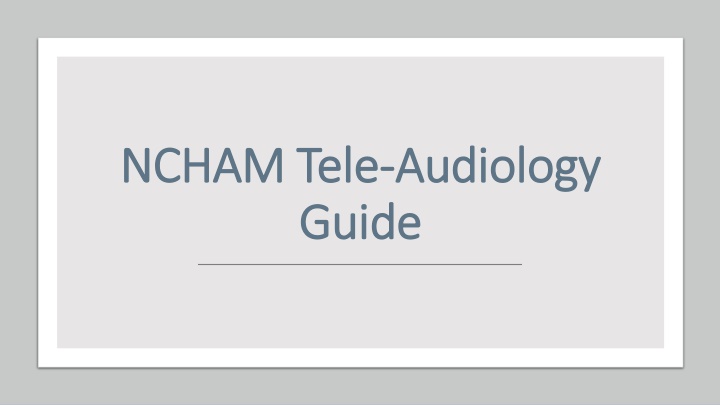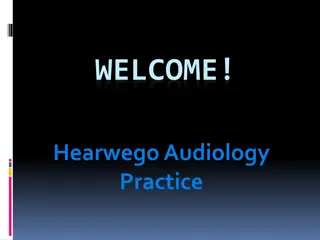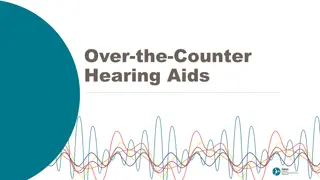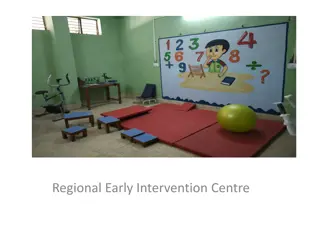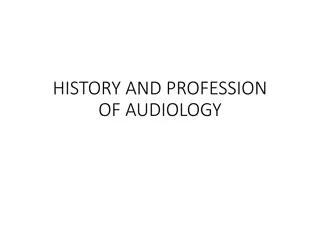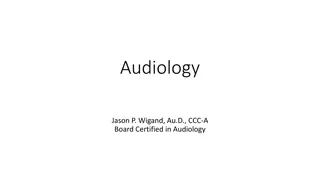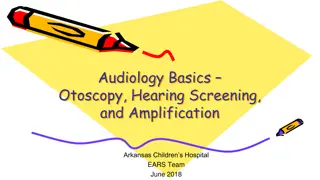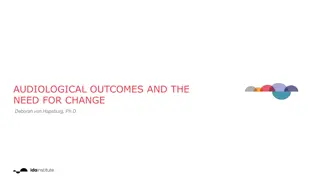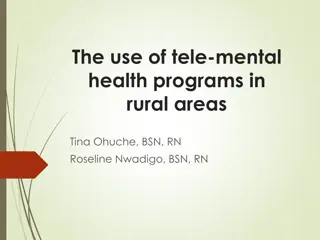NCHAM Tele-Audiology Learning Community Guide
Discover valuable resources for conducting tele-audiology services through the NCHAM Tele-Audiology Learning Community. This guide directs you to essential articles and provides instructions for self-enrollment in the learning community. Explore topics such as regulations, licensure, quality improvement, and tele-audiology program development. Enhance your knowledge and skills in remote service delivery with over 65 additional resources available. Enroll now and benefit from a wealth of tele-audiology information.
Download Presentation

Please find below an Image/Link to download the presentation.
The content on the website is provided AS IS for your information and personal use only. It may not be sold, licensed, or shared on other websites without obtaining consent from the author.If you encounter any issues during the download, it is possible that the publisher has removed the file from their server.
You are allowed to download the files provided on this website for personal or commercial use, subject to the condition that they are used lawfully. All files are the property of their respective owners.
The content on the website is provided AS IS for your information and personal use only. It may not be sold, licensed, or shared on other websites without obtaining consent from the author.
E N D
Presentation Transcript
NCHAM Tele NCHAM Tele- -Audiology Guide Guide Audiology
Examples of Tele- Audiology General Resources Training for Remote Sites Quality Improvement Developing a Tele- Audiology Program Regulations, Licensure, & Reimbursement Main Page Main Page Start Here Telehealth Video Conferencing Resources Hearing Review ABC Guide Equipment Protocols Cochlear Implants Hearing Aids
Welcome! Welcome! This Introductory Guide to the NCHAM Tele-Audiology Learning Community identifies the resources that may be most beneficial as you prepare to conduct tele-audiology services. To be directed to the resources of most interest to you, return to the main page and click on the topics which are applicable to your needs. You will then be directed to helpful resources. In addition to the articles listed in this Introductory Guide, the NCHAM Tele-Audiology Learning Community has over 65 additional tele-audiology resources available. See below for instructions to self-enroll in the Tele-Audiology Learning Community: Step 1: Follow this link https://ncham-moodle.eej.usu.edu/moodle/ Step 2: Click on Tele-Audiology Learning Community located under Available Courses Step 3: Click on Create new account located under Is this your first time here? Step 4: Fill out the information needed to create an account, and click on Create my new account Step 5: Check your email for an email titled NCHAM Moodle: account confirmation Step 6: Follow the link in the email to confirm your new account Step 7: Click on Continue Step 8: Self-enroll in the course using the enrollment key: 1898 Main Page Next Page
General Resources General Resources
General Resources General Resources ASHA: Telepractice: An Overview & Best Practices This article presents a general overview of telepractice, including terminology and definitions; ethical considerations; privacy and security; reimbursement policy and trends; considerations for client selection; and telepractice resources. Hearing Review - eAudiology: Shifting from Theory to Practice This article provides recommendations to hearing healthcare providers for integrating eAudiology into their current practices. Previous Page Main Page Next Page
General Resources General Resources IJA - Applied Tele-Audiology in a Clinical Practice During the Past Decade: A Scoping Review The purpose of this scoping review was two-fold, (1) to provide information about the characteristics, type of service delivery, participant information and outcomes related to tele- audiology in clinical populations, and (2) to describe documented facilitators and barriers to tele-audiology delivery from the perspectives of practitioners and service recipients. Knowledge of these findings can assist audiologists in considering remote service delivery options for their practices. How to do a Telemedicine Visit the Right Way: A Checklist This article provides helpful checklists regarding technology for both providers and patients to use before their first tele-audiology visit. Hearing Review Telehealth This link will lead you to the latest tele-audiology updates and resources. Previous Page Main Page Next Page
General Resources General Resources AAA - Telehealth: The Great Equalizer This article highlights the need for tele-audiology in rural America, and it discusses how tele-audiology could be implemented. ASHA - Current Practices in Tele-Audiology This resources provides a brief overview of several successful tele-audiology practices. ASHA A Systematic Review of Telehealth Applications in Audiology This is a systematic review of published, peer-reviewed research investigating the efficacy of telehealth to deliver audiology services and the perceptions of patients/clients who received these services. Previous Page Main Page Next Page
General Resources General Resources AAA A White Paper on the Status of Tele-Audiology This paper discusses several areas of tele-audiology and how they must be considered to improve hearing healthcare and its accessibility. NCHAM: EHDI/UNHS Program Guidelines and Websites by State Links to web sites having information related to the various facets of early (newborn/infant) hearing detection and intervention programs in U.S. states, territories and commonwealths, including their guidelines. ASHA Sig 18 Acquiring Knowledge From Other Disciplines This is a helpful article that provides resources and discusses considerations for telehealth, as well as describing how various professions can work together to guide telehealth development, relevant to pediatric tele-audiology Previous Page Main Page Next Page
General Resources General Resources National Consortium of Telehealth Resource Centers The National Consortium of Telehealth Resource Centers (NCTRC) is an affiliation of the 14 Telehealth Resource Centers funded individually through cooperative agreements from the Health Resources & Services Administration, Office for the Advancement of Telehealth Listing of 14 Regional Telehealth Resource Centers NCHAM eBook: Chapter 20 Using Telepractice to Improve Outcomes for Children Who Are Deaf or Hard of Hearing & Their Families This resource discusses the use of tele-audiology and how it can be effectively used to adhere to the EHDI system's 1-3-6 rule. The resource also addresses several aspects to consider, as well as issues that may arise when using tele-audiology to provide services to children with hearing loss and their families. Previous Page Main Page Next Page
Examples of Tele Examples of Tele- -Audiology Audiology
Examples of Tele Examples of Tele- -Audiology Audiology NCHAM JEHDI: South Dakota Early Hearing Detection and Intervention Program: Using Teleaudiology to Conduct Infant Diagnostic Assessments This article describes the South Dakota EHDI program's tele-audiology project. They describe their use of a synchronous, hub-and-spoke, tele-audiology service delivery model used to complete infant hearing assessments. NCHAM JEHDI: Infant Diagnostic Evaluation Via Teleaudiology Following Newborn Screening in Eastern North Carolina This article describes a pilot Tele-Audiology project which aimed to provide diagnostic evaluations to infants via tele-audiology in eastern North Carolina. Previous Page Next Page Main Page
Examples of Tele Examples of Tele- -Audiology Audiology ASHA SIG 18 - Audiological Care & Telehealth in Remote Alaska This article discusses the provision of tele-audiology services in remote Alaska used to provide hearing healthcare to patients across the lifespan with applicable information for providing pediatric tele-audiology services. Telehealth-Enabled Auditory Brainstem Response Testing for Infants Living in Rural Communities: The British Columbia Early Hearing Program Experience This article describes a study by the British Columbia Early Hearing Program which implemented diagnostic ABR assessments for infants in rural communities. Previous Page Main Page Next Page
Examples of Tele Examples of Tele- -Audiology Audiology AAA: Current Practices in Tele-Audiology This article briefly describes several current tele-audiology practices, as well as describing areas in which tele-audiology is beneficial and what issues should be considered. Hearing Review Infant Diagnostic Evaluations Using Tele-Audiology This article describes the use of tele-audiology in conducting infant diagnostic auditory evaluations so that audiologists at the Children's Hospital Colorado could provide services to infants located in Guam. Hearing Review California Tele-Audiology Program Improves Access to Audiologists Researchers at UC Davis have shown that the California Tele-Audiology Program (CTP), which provides follow-up diagnostic evaluations for infants who did not pass their initial newborn hearing test, dramatically improves access to audiologists. Families with access to CTP had 100% participation in follow up evaluations. Previous Page Main Page Next Page
Examples of Tele Examples of Tele- -Audiology Audiology ASHA EHDI Tele-Audiology This article describes the development, implementation, outcomes, and advantages and disadvantages of using a tele-audiology approach to deliver diagnostic audiological evaluations and speech-language early intervention services to pediatric patients at the Children's Hospital Colorado. ASHA Listening & Learning This paper describes the University of Akron's use of tele-audiology to provide Auditory-Verbal Therapy (AVT) to children with hearing loss and aural rehabilitation to adults with hearing loss. The paper describes the rationale behind their approach, as well as a general framework to guide service delivery. Previous Page Main Page Next Page
Developing a Tele Developing a Tele- -Audiology Program Program Audiology
Developing a Tele Developing a Tele- -Audiology Program Audiology Program Hearing Review - Critical Steps in Establishing a Teleaudiology Practice, Part 1 This article discusses several critical aspects to consider when thinking about tele-audiology including the importance and the benefits of tele-audiology, and the article also provides a guide to developing a successful tele-audiology program. Hearing Review - Critical Steps in Establishing a Teleaudiology Practice, Part 2 This article addresses considerations for implementing tele-audiology such as software requirements, equipment needs, and billing and coding. Main Page Next Page Previous Page
Developing a Tele Developing a Tele- -Audiology Program Audiology Program ASHA - Telepractice Resources During COVID-19 This resource provides ASHA links for planning and providing tele-audiology services. ASHA - Getting Started with Teleaudiology This article provides information about tele-audiology, and it also explores helpful aspects to consider when planning for and implementing tele-audiology. AAA - The ABCs of Establishing a Remote Clinic This resource provides an outline of basic steps and considerations for starting tele-audiology practice. Previous Page Main Page Next Page
Developing a Tele Developing a Tele- -Audiology Program Audiology Program ASHA Tele-Audiology Models This article describes an adult tele-audiology model, as well as addressing benefits, concerns, and considerations that should be thought of when implementing tele-audiology. Hearing Health Today: The Rise of Telemedicine Podcast with Dr. Allision Biever with her perspective on how clinics can use telemedicine in practice and also provide insight into what's in store for the future of hearing health care, both challenges and opportunities Previous Page Main Page Next Page
Developing a Tele Developing a Tele- -Audiology Program Audiology Program AAA COVID-19 & Clinical Recommendations This article provides resources, clinical recommendations, and actions that should be taken within clinical audiology practice in response to the COVID-19 pandemic. NCHAM Tips & Tools to Support Effective Telepractice Sessions This video presentation by Dr. K. Todd Houston helpfully describes ways to be successful when implementing and using telepractice. ASHA Top 10 Ethical Considerations in Using Telepractice This resource lists the top ten aspects to consider when implementing telepractice so that you can provide effective and ethically sound telepractice services. Previous Page Main Page Next Page
Developing a Tele Developing a Tele- -Audiology Program Audiology Program ASHA 5 Steps to Get Started in Telepractice This resource provides helpful tips and information on how to get started with telepractice. ASHA: The Role of Patient-Site Facilitators in Teleaudiology: A Scoping Review Teleaudiology helps improve access to hearing health care by overcoming the geographic gap between providers and patients. In many teleaudiology encounters, a facilitator is needed at the patient site to help with hands-on aspects of procedures. The aim of this study was to review the scope and nature of research around patient-site facilitators in teleaudiology. They focused on identifying the facilitators' background, training, and responsibilities. Previous Page Main Page Next Page
Developing a Tele Developing a Tele- -Audiology Program Audiology Program Hearing Review The Business Case for Teleaudiology This article discusses questions to consider regarding implementing tele- audiology as a means of improving professional presence and productivity. National Compendium of Best Practices in Telehealth Services This resource is a complete compendium of best practices developed from California Telehealth Resource Center s 20 years of experience developing telehealth programs that lays all things to consider when developing a telehealth program. Iowa: Gathering Needs & Resource Assessment to Guide Tele- Audiology This outline offers important considerations to guide the development of a tele- audiology effort. Previous Page Main Page Next Page
Hearing Review ABC Guide Hearing Review ABC Guide
Hearing Review ABC Guide Hearing Review ABC Guide Hearing Review (Phonak 1) Ten Steps to Licensure & Stakeholder Support This resource from Phonak ABCs step-by-step guide has outlined 10 helpful steps to follow when implementing tele-audiology at your hearing healthcare facility. Hearing Review (Phonak 2) Ten Steps to Optimizing Your eAudiology Practice Environment This resource from Phonak ABCs step-by-step guide provides helpful steps and tips to follow in order for you to provide more effective tele-audiology services. Hearing Review (Phonak 3) Ten Steps to Clinical Applications & Providing Feedback for eAudiology This resource from Phonak ABCs step-by-step guide has described steps to follow when implementing tele-audiology at your facility, as well as how to receive feedback to further improve the tele-audiology services that you provide. Previous Page Main Page Next Page
Hearing Review ABC Guide Hearing Review ABC Guide Hearing Review (Phonak 4) Ten Steps to Employee Training This resource from Phonak ABCs step-by-step guide provides a helpful list of steps to follow when training employees in the use of tele-audiology and how to make this implementation process pleasant for both employees and patients. Hearing Review (Phonak 5) Ten Steps to Scheduling & Reimbursement for eAudiology This resource from Phonak ABCs step-by-step guide provides tips for scheduling and reimbursement for tele-audiology services. Previous Page Main Page Next Page
Hearing Review ABC Guide Hearing Review ABC Guide Hearing Review (Phonak 6) - Ten Steps to Technology & Connectivity for eAudiology This resource from Phonak ABCs step-by-step guide outlines steps to follow to help you ensure that you have the proper technology and connection capabilities needed to provide tele-audiology services. Hearing Review (Phonak 7) Ten Steps to Talking to Clients about eAudiology This resource from Phonak ABCs step-by-step guide provides helpful guidance on how to determine tele-audiology need from your patients, as well as how to inform your patients about tele-audiology. Hearing Review (Phonak 8) Ten Steps to Client Selection & Other Consideration for eAudiology This resource from Phonak ABCs step-by-step guide discusses key questions and characteristics of patients who will likely benefit from the use of tele-audiology services. Previous Page Main Page Next Page
Hearing Review ABC Guide Hearing Review ABC Guide Hearing Review (Phonak 9) Ten Steps to Family-Centered Care for eAudiology This resource from Phonak ABCs step-by-step guide provides helpful tips to consider in order to provide effective and meaningful family-centered care while using a tele-audiology service delivery model. Hearing Review (Phonak 10) - Ten Steps tp Record Keeping & Data Protection for eAudiology This resource from Phonak ABCs step-by-step guide discusses strategies to consider in order to ensure proper security when maintaining patient records and other health information when using tele-audiology service delivery. Previous Page Main Page Next Page
Equipment Equipment
Equipment Equipment Hearing Review - How to Use Teleaudiology Technologies in a New Setup or in an Existing Office This article provides specific details of tele-audiology equipment options as well as delivery modalities and how to set them up. ***For information about specific equipment options, please review the Equipment section in the NCHAM Tele-Audiology Learning Community. Previous Page Main Page Next Page
Telehealth Video Telehealth Video Conferencing Resources Conferencing Resources
Telehealth Video Conferencing Resources Telehealth Video Conferencing Resources ASHA SIG 18/ Everything SLP - It's All About the Platform This article compares several tele-practice platforms (G Suite, WebEx, GoToMeeting, doxy.me, Zoom, and Microsoft Teams. While written for SLPs, this information may also be applicable for audiological interventions, troubleshooting, and counseling. Remote Connectivity Technology: Privacy Considerations for eAudiology Applications This article from Canadian Audiologist describes pertinent information regarding tele- audiology such as privacy, privacy legislation, technology, telemedicine platforms, and ethics. ***For more information about specific video conferencing platforms, please review the Telehealth Video Conferencing Resources section in the NCHAM Tele-Audiology Learning Community. Previous Page Main Page Next Page
Regulations, Licensure, Regulations, Licensure, & Reimbursement & Reimbursement
Regulations, Licensure, & Reimbursement Regulations, Licensure, & Reimbursement ASHA: COVID-19 Tracking of State Laws and Regulations for Telepractice and Licensure Policy This ASHA document provides state-by-state laws and regulations regarding telepractice and licensure policies. AAA: Coding and Reimbursement Specialty Series: Telehealth This resource provides information on billing, coding, and reimbursement for tele-audiology. The article also gives helpful examples for coding and billing for tele-audiology services. Previous Page Main Page Next Page
Regulations, Licensure, & Reimbursement Regulations, Licensure, & Reimbursement ADA: Procedures Which May be Provided Via Telehealth with Existing Technologies This document provides a list of procedures that may be delivered via tele- audiology, also including applicable billing codes. AAA: COVID-19 Telehealth Update and Guidance Many audiologists are wondering if remote services can be billed and reimbursed. This guide will help you understand options that are available to audiologists at the present time. Previous Page Main Page Next Page
Regulations, Licensure, & Reimbursement Regulations, Licensure, & Reimbursement ASHA COVID-19: Tracking of State Medicaid Telepractice Policies and Emergency Telepractice Orders ASHA COVID-19: Tracking of Commercial Insurance Telepractice Policies Plan NCHAM The Impact of Privacy Regulations (White Paper) Creating a system of effective services requires the exchange of information among hospitals, audiologists, physicians, and Part C Early Intervention programs. Federal privacy regulations, specifically the Health Insurance Portability and Accountability Act (HIPAA), the Family Educational Rights and Privacy Act (FERPA), and Part C regulations of the Individuals with Disabilities Education Act (IDEA) which incorporates confidentiality provisions under FERPA, must be followed when such information is exchanged. Previous Page Main Page Next Page
Protocols Protocols
Protocols Protocols EHDI/UNHS Program Guidelines and Websites by State Links to web sites having information related to the various facets of early (newborn/infant) hearing detection and intervention programs in U.S. states, territories and commonwealths, including their guidelines. 2019 JCIH Position Statement This is the latest Joint Committee on Infant Hearing Position Statement which outlines best practice in infant hearing screening, diagnostics and early intervention. EHDI Audiology Assessment Protocol (British Columbia, Canada) The Audiology Assessment Protocol from the BC Early Hearing Program provides guidelines for diagnostic audiological assessments for pediatrics. Previous Page Main Page Next Page
Protocols Protocols Teleaudiology Infant Hearing Assessment Toolkit This toolkit, developed by the South Dakota EHDI Collaborative, is a detailed listing of the steps necessary to conduct an ABR remotely. It lists the specific steps for the hub and spoke sites before, during, and after the appointment, as well as the infrastructure needed. It references the training documents included in the "Training for Remote/Spoke Sites" section of the Learning Community. ABR Protocol (Ontario, Canada) This document describes the Protocol for Auditory Brainstem Response-Based Audiological Assessment (ABRA) from the Ontario Infant Hearing Program. Previous Page Main Page Next Page
Training for Remote Sites Training for Remote Sites
Training for Remote Sites Training for Remote Sites South Dakota - Training Videos File This PDF document provides a list of videos from the Communication Support Through Aids and Technology YouTube channel that teach various skills such as ABR electrode placement and removal, insert placement and removal, bone oscillator placement, and swaddling. (List and training video are available by signing into the Tele-Audiology Learning Community.) The Role of the Patient-Site Facilitators in Teleaudiology: A Scoping Review The aim of this study was to review the scope and nature of research around patient-site facilitators in tele-audiology. The study focused on identifying the facilitators' background, training, and responsibilities. Previous Page Main Page Next Page
Training for Remote Sites: Training for Remote Sites: South Dakota Quick Reference Guides South Dakota Quick Reference Guides Diagnostic Audiology Quick Reference Guide Equipment Set-up Quick Reference Guide Otoscopy Quick Reference Guide Tympanometry Quick Reference Guide OAE Quick Reference Guide ABR Quick Reference Guide ABR Electrode & Ear Insert Placement Quick Reference Guide Previous Page Main Page Next Page
Hearing Aids Hearing Aids
Hearing Aids Hearing Aids ASHA/AJA - Stories form the Webcams Cincinnati Children's Hospital Medical Center Audiology Telehealth and Pediatric Audiology Device Services This article reviews the benefits of tele-audiology, and it also describes multiple case studies which bring to light the usefulness of tele-audiology in providing device support to pediatric patients and their families. AAA: Remote Hearing Aid Support: The Next Frontier This article describes a study which analyzed the effectiveness and patient satisfaction of tele-audiology hearing aid appointments. Though this study focused on serving an adult population, the results of the study are relevant to pediatric tele-audiology hearing aid services. Previous Page Main Page Next Page
Cochlear Implants Cochlear Implants
Cochlear Implants Cochlear Implants Remote Programming for Cochlear Implants This study investigated the safety and efficacy of remote programming of cochlear implants for patients 12 years and older. ASHA: Pediatric Cochlear Implant Mapping Via Telepractice This article describes a research study which looked at the validity of performing cochlear implant mapping with young children using tele-audiology. Techniques for Remotely Programming Children with Cochlear Implants Using Pediatric Audiological Methods via Telepractice The purpose of this report is to describe the equipment setup and techniques for successfully testing behavioral thresholds in young children with cochlear implants (CIs) using telepractice. The report also discusses challenges associated with pediatric CI programming that are unique to the use of distance technology and ways to overcome those challenges. Previous Page Main Page Next Page
Cochlear Implants Cochlear Implants AJA - Have Cochlear Implant, Won't Have to Travel: Introducing Telemedicine to People Using Cochlear Implants This article describes a study which analyses the effectiveness of tele-audiology for cochlear implant appointments for adults. Though the study was conducted with an adult population, the information covered is helpful and can be applied to pediatric tele-audiology. Use of Telehealth for Research and Clinical Measures in Cochlear Implant Recipients: A Validation Study This is an interesting research article comparing cochlear implant measures obtained during face-to-face appointments versus tele-audiology appointments with both adult and pediatric patients. Previous Page Main Page Next Page
Quality Improvement Quality Improvement
Quality Improvement Quality Improvement NCHAM eBook: Chapter 27 Quality Improvement: Small Changes that can Make a Big Difference This resource discusses EHDI's quality improvement method, the Model for Improvement, used to reduce loss to follow-up in newborn hearing screening programs and how smalls changes have made a big difference. PDSA Worksheet (Worksheet is available by signing into the Tele-Audiology Learning Community.) Previous Page Main page Next Page
Quality Improvement Quality Improvement Evaluating Tele-Audiology This presentation from Vanderbilt University Medical Center describes a research study and design aimed at evaluating the success of a tele-audiology program. Evaluating the Success of a Tele-Audiology Program This presentation from Vanderbilt University Medical Center describes a research study and design aimed at evaluating the success of a tele-audiology program. Previous Page Main page
